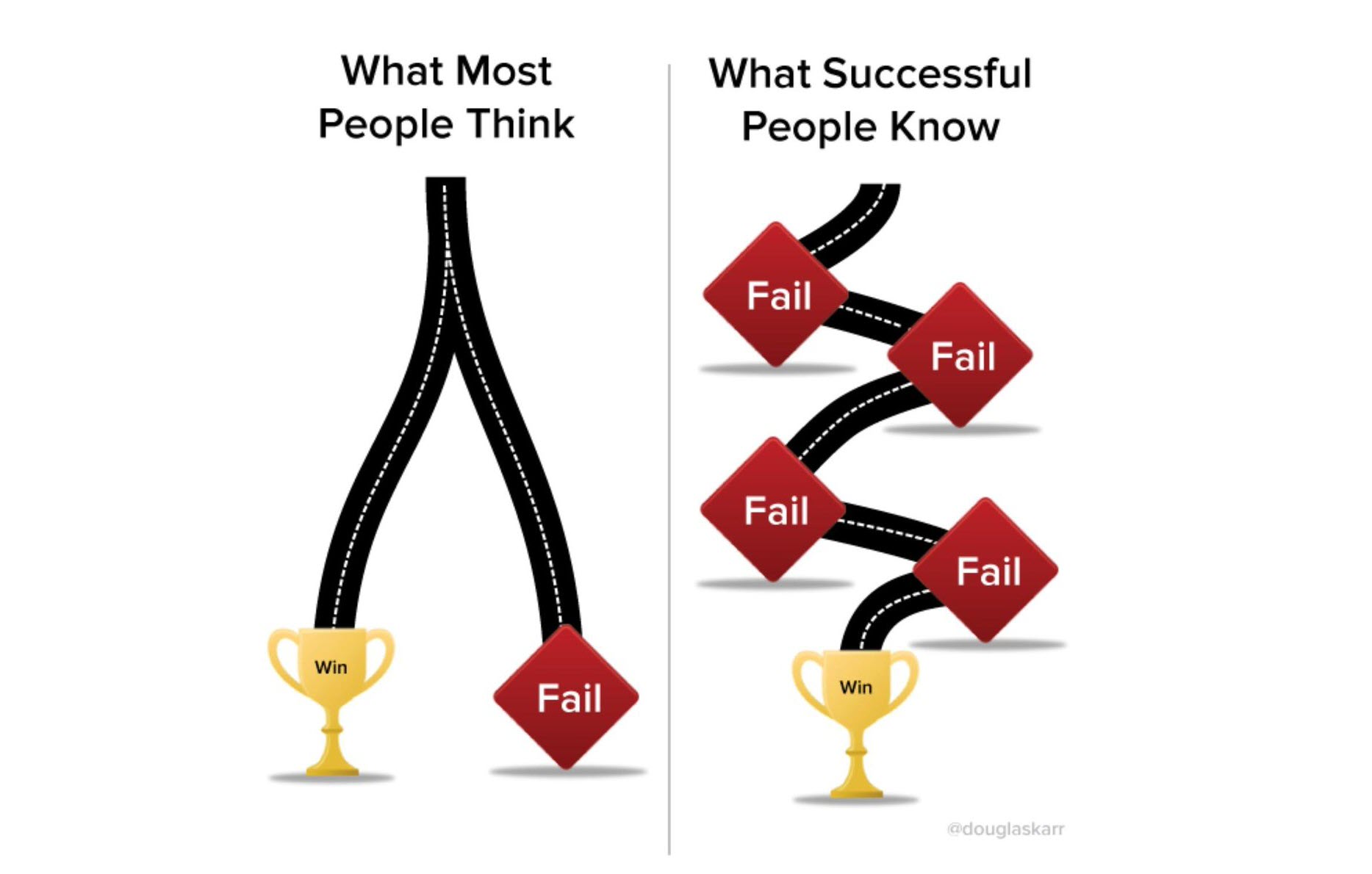
Fail early, fail often, fail cheap, fail safe but always fail forward
Last updated: March 02, 2024 Read in fullscreen view
- 27 Oct 2020
 8 principles of Agile Testing
8 principles of Agile Testing - 16 Jun 2022
 Rapid Application Development (RAD): Pros and Cons
Rapid Application Development (RAD): Pros and Cons - 01 Oct 2020
 Fail fast, learn faster with Agile methodology
Fail fast, learn faster with Agile methodology - 14 Oct 2021
 Advantages and Disadvantages of Time and Material Contract (T&M)
Advantages and Disadvantages of Time and Material Contract (T&M) - 09 Oct 2022
 Key Advantages and Disadvantages of Agile Methodology
Key Advantages and Disadvantages of Agile Methodology
Failing fast and failing forward is a pretty established concept and is a 'cute' way of saying “Learn by Doing.” Understand there will be failures, and keep moving forward—no wasting time. Your laser focus on getting the idea/business/product for your business right is of primary importance.
Lesson 1: You Might Not Be Responsible For Your Failures, But You Can Sure Take Responsibility For Your Success.
This year the G20 summit took place in Hamburg, Germany. It’s an important political event on a global scale, with some of the world’s most powerful countries’ leaders sitting together, talking about economics, finances, health, security, and so on. There are always protesters demonstrating for certain causes during the event, but this year, it was engulfed in a wave of vandalism.
Masked men stormed around the city, destroying everything in sight, just for the fun of it. They torched cars, ruined public facilities and trashed entire stores. I remember seeing the owner of an organic grocery store standing in his 500,000 € loss.
This failure wasn’t his fault by any means. But how fast he turns it around is up to him. A similar thing happened to Greg Horn in 1997. His store was destroyed by the Kentucky Floods and guess what the only thing was he hadn’t insured it for? Water.
Instead of giving up, though, he took responsibility for getting back to success. He continued to support his 80 employees and scraped together the $1 million it took to repair everything. Within 21 days, he was back up and running.
It’s not always your fault when things go wrong. But when you give up and sit and wallow, that is.
Lesson 2: Turn Failure Into Knowledge And Knowledge Into Success.
Maxwell tells an interesting story from another classic book, Art & Fear by Ted Orland. The teacher of a ceramics class divides her students into two groups. She told the first group they’d be graded based on how many pieces they created over the course of the class. The second group was supposed to make just one piece of pottery, but make that the best they can.
Your gut might tell you the second group should produce better work, but actually, the first group completely outgunned them when it came to quality of their creations. Why? Two reasons:
- Making multiple pieces took the pressure off every single one. Failing wasn’t so bad.
- Going through multiple stages of failure allowed them to learn from each one and improve their next piece.
This is how failure leads to success. When we put too much pressure on ourselves, we often don’t have the stomach to re-visit our failure. But how else should we find out what we did wrong?
Fail-Fast and Fail-Safe in programming:
Fail-Fast systems abort operation as-fast-as-possible exposing failures immediately and stopping the whole operation.
Whereas, Fail-Safe systems don't abort an operation in the case of a failure. Such systems try to avoid raising failures as much as possible.
Make more. Quantity over quality. Be determined to understand your failures. And then improve each time.
Lesson 3: Three Things Help You Make The Most Of The Opportunities That Come Your Way.
When your perspective shifts and failure slowly begins to transform into the stepping stone it actually is, you’ll be much more willing to take each and every single opportunity that comes your way. But just because failing isn’t so bad any more that doesn’t mean you should set out to bomb on purpose.
Instead, try to make the most of each shot you get. John suggests working on three things to ensure you do:
- Set clear goals. Specific goals have benefits on so many levels, but the most obvious is that for each opportunity, you’ll instantly know whether to take it or not.
- Work on your social skills. Even if it’s just about keeping more opportunities coming, mastering networking, communicating and bringing people together around a shared cause is worth spending some time on.
- Keep a positive mindset. I know optimism doesn’t come natural to everyone. But I think it’s the mindset most worth working on. I truly believe it’s what most of us confuse with happiness.
These are just starting points. But not only will they help you make the most of failing more, they’re even great skills to practice failing forward in. The point is to not let setbacks set you back for too long. I hope this book will help you do just that.
John C. Maxwell’s most popular book is The 21 Irrefutable Laws Of Leadership. This one isn’t quite as practical. It’s more on the inspirational side. But if it gets you to adjust your perspective about failure even slightly, it’ll be well worth your time. If you liked this summary, give Failing Forward a go.
What Else Can You Learn From The Blinks?
- How long it takes entrepreneurs on average before they succeed
- Who’s responsible for the “New Coke” disaster
- How to draw dividends from your failures
- One of the most inspiring stories in the history of tennis
- Why taking your bike or walking instead of the car might not be so much safer than you think it is





















